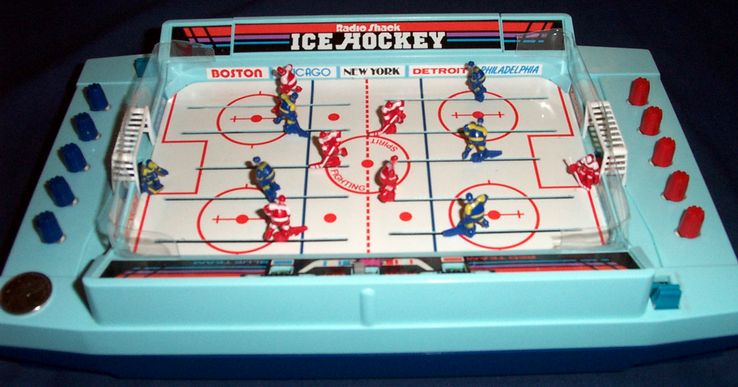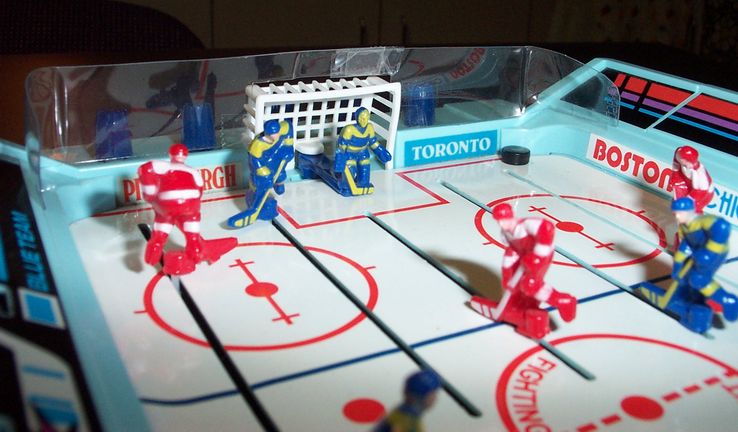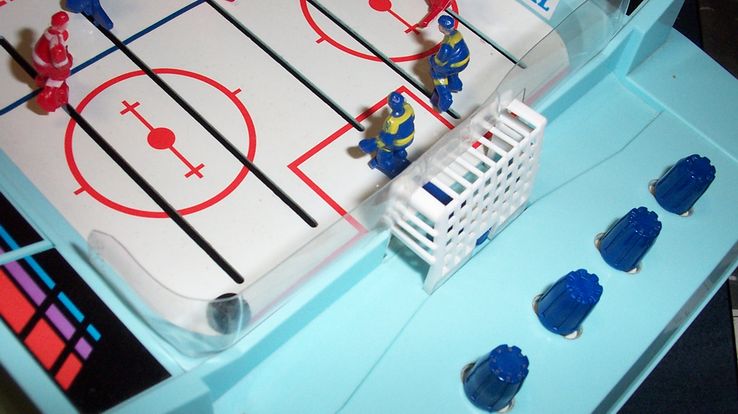Table Hockey Glass
Making
a great game even better.
Introduction
My friend Dennis has this neat little Radio Shack electronic table hockey board, shown below. It runs on a pair of C batteries powering a single motor. The blue and red knobs seen in the picture on the left and right can be pushed forward or pulled backward, which causes some gears inside the casing to connect to an axle spun by the motor, making the corresponding player move up or down the ice. It's really quite brilliantly designed.

My uncle sent me the exact same thing one year for Christmas at least 10 years ago, but when we got it, it didn't work: the players wouldn't move. The axles had probably been dislodged when the package was being shipped. No one thought to open it up and try to fix it -- maybe my parents thought of it, but the thing makes the most horrible RNNNNNNNNN noise you've ever heard, so, if one of them did think of it, they might have kept the idea to themselves ; ).
Returning to the present... Dennis and I have best-of-three competions with the game every day that we aren't too busy to. We've even been keeping statistic sheets in an MS Excel document recording the scores of the games and which players scored which goals: The centres score about 45% of the goals, the wingers, 30%, and the defense, 20%; the remaining 5% of the time, we score on ourselves; Dennis has scored a goal with his goalie as well. I play as red (Canada) and Dennis plays as Blue (Sweden). Why we always play the same teams, I don' t know -- maybe because Dennis is much blonder and taller than I am.
Long story short: hockey game lots of fun!
The Problem
One little problem with the game, however, is that it's fairly easy to shoot the puck over the boards in the corners, so every few minutes we're forced to chase down an errant puck. And the puck is TINY: About 7.5mm in diameter. I'm surprised we've never lost a puck under the fridge.
It's not a horrible thing, shooting the puck out of the board, since it gives me a chance to show off my goalie reflexes, but it does get a bit old after the 15th time.
The Solution
I decided that I was going to make glass for the boards of this miniscule hockey rink.
I needed a flat, clear material, but the closest I could find was a 591mL Coke bottle. I took the label off and cut 4 vertical strips out of the bottle. Above the label, the bottle bulges out a bit and then curves inward toward the top of the bottle. This little bulge was an excellent place to have the glass curve around the corner of the rink.

Two of these strips make up the glass at each end of the rink. To get the plastic to curve around at the corners of the rink, I wrapped the plastic around a mechanical pencil and heated it up above a candle, to cement a sharp curve into the plastic. Candles may not be allowed in residence, but, this was in the name of table hockey! No jury in the world would convict me! In Canada, anyway...maybe. And Sweden. Maybe.

The glass is simply taped to the boards with some scotch tape. The ugly taping above the goal couldn't be avoided -- I couldn't get the two peices of plastic to melt together well ; ).
My friend Dennis has this neat little Radio Shack electronic table hockey board, shown below. It runs on a pair of C batteries powering a single motor. The blue and red knobs seen in the picture on the left and right can be pushed forward or pulled backward, which causes some gears inside the casing to connect to an axle spun by the motor, making the corresponding player move up or down the ice. It's really quite brilliantly designed.

Notice quarter in the bottom left for scale
My uncle sent me the exact same thing one year for Christmas at least 10 years ago, but when we got it, it didn't work: the players wouldn't move. The axles had probably been dislodged when the package was being shipped. No one thought to open it up and try to fix it -- maybe my parents thought of it, but the thing makes the most horrible RNNNNNNNNN noise you've ever heard, so, if one of them did think of it, they might have kept the idea to themselves ; ).
Returning to the present... Dennis and I have best-of-three competions with the game every day that we aren't too busy to. We've even been keeping statistic sheets in an MS Excel document recording the scores of the games and which players scored which goals: The centres score about 45% of the goals, the wingers, 30%, and the defense, 20%; the remaining 5% of the time, we score on ourselves; Dennis has scored a goal with his goalie as well. I play as red (Canada) and Dennis plays as Blue (Sweden). Why we always play the same teams, I don' t know -- maybe because Dennis is much blonder and taller than I am.
Long story short: hockey game lots of fun!
The Problem
One little problem with the game, however, is that it's fairly easy to shoot the puck over the boards in the corners, so every few minutes we're forced to chase down an errant puck. And the puck is TINY: About 7.5mm in diameter. I'm surprised we've never lost a puck under the fridge.
It's not a horrible thing, shooting the puck out of the board, since it gives me a chance to show off my goalie reflexes, but it does get a bit old after the 15th time.
The Solution
I decided that I was going to make glass for the boards of this miniscule hockey rink.
I needed a flat, clear material, but the closest I could find was a 591mL Coke bottle. I took the label off and cut 4 vertical strips out of the bottle. Above the label, the bottle bulges out a bit and then curves inward toward the top of the bottle. This little bulge was an excellent place to have the glass curve around the corner of the rink.

(If I
ever need to draw a girl wearing
a pair of jeans, I know now how to draw the bottom half)
Two of these strips make up the glass at each end of the rink. To get the plastic to curve around at the corners of the rink, I wrapped the plastic around a mechanical pencil and heated it up above a candle, to cement a sharp curve into the plastic. Candles may not be allowed in residence, but, this was in the name of table hockey! No jury in the world would convict me! In Canada, anyway...maybe. And Sweden. Maybe.

Another thing that really impresses me
about this game is the amount of detail on the tiny faces of the
players.
I never even noticed that they have noses until I took this picture!
I never even noticed that they have noses until I took this picture!
The glass is simply taped to the boards with some scotch tape. The ugly taping above the goal couldn't be avoided -- I couldn't get the two peices of plastic to melt together well ; ).
The Result
The glass has been remarkably effective in reducing the number of times the puck escapes the rink each game. It still happens, but I would estimate that the frequency has dropped by at least 75%.
An unexpected and added benefit of having glass at the ends of the rink is that there is now never any confusion about whether a goal was scored or the puck simply jumped over the boards. As can be seen in the picture below, when a goal is scored, the puck leaves the net through an opening at the bottom of each side of the net so that it is easy to retrieve. The puck is so small and moves so fast that we often can't see the exact path the puck followed and can't tell if it went through the hole or went over the boards and ended up in the goal trough. Now, there can be no doubt: There have been instances when we've declared a goal simply on the reason, "it didn't go over the glass, so it must have gone through the net."

The glass doesn't obstruct your view of
the game. Not much, anyway.
I intend to also add glass to my full-sized table hockey board. I guess I will have to use several 2 L pop bottles for that project!